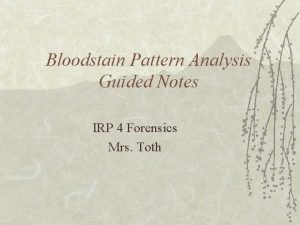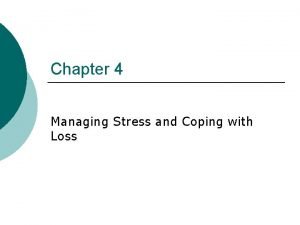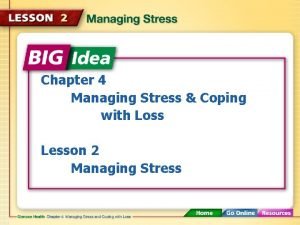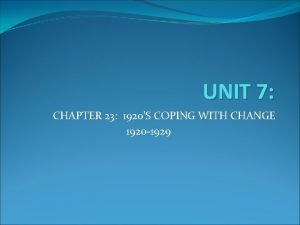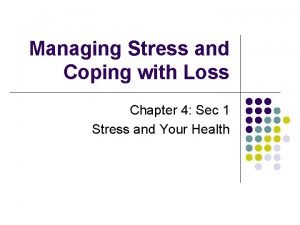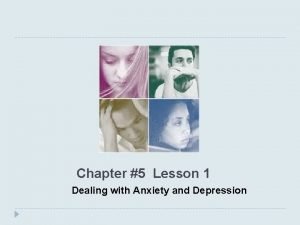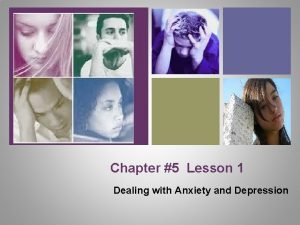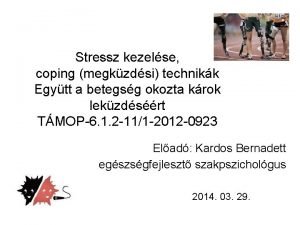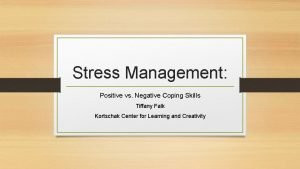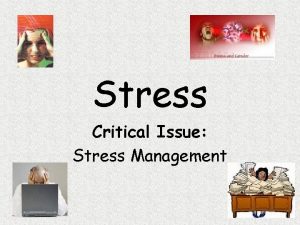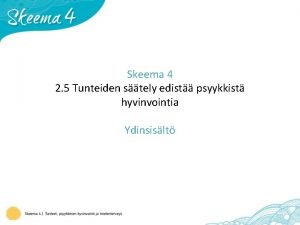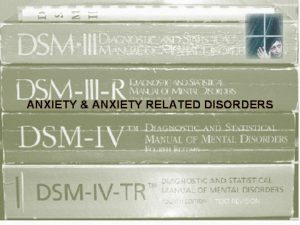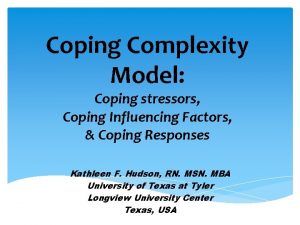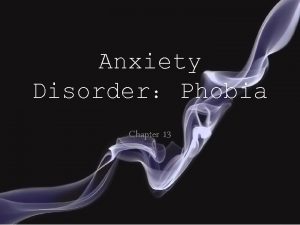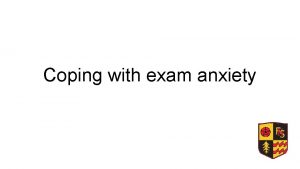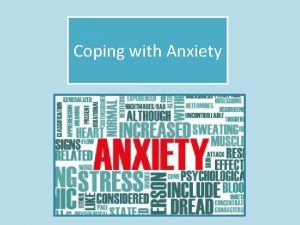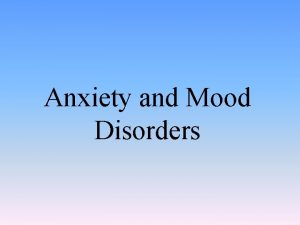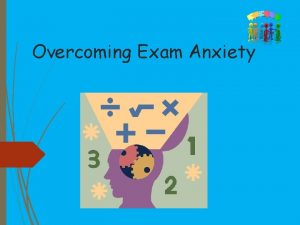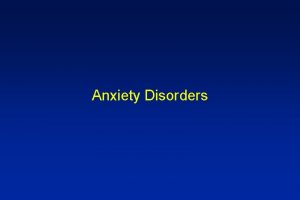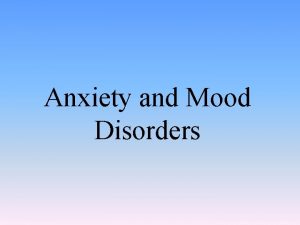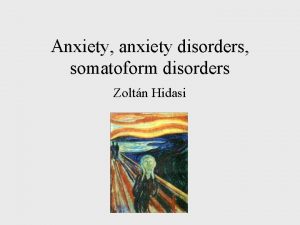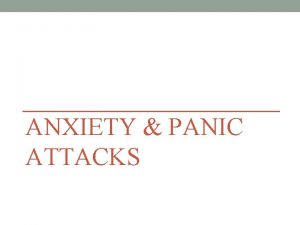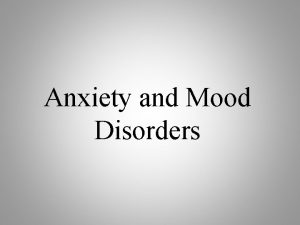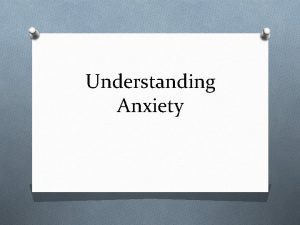Module 6 Chapter 6 Coping with Anxiety Wipe

























- Slides: 25

Module 6/ Chapter 6 Coping with Anxiety "Wipe out anxiety before it wipes you out. "

CHAPTER 6 OUTLINE n What is Anxiety? n Depression n Coping Mechanisms n Rational Emotive Therapy (RET) n Simplified Kundalini Yoga (SKY) n Gestalt Therapy n Systematic Desensitization n Cognitive Behavioral Therapy (CBT) n Emotional Intelligence n Summary Points

Basic Terms n Anxiety: State of mind which perceives the outside event or one’s action as resulting in negative outcomes and one’s lack of ability to cope. n Coping: The ability to deal with and overcome problems and difficulties encountered in life. n State Anxiety: Anxiety due to being in a given stressful situation. n Trait Anxiety: Anxiety due to one’s personality disposition.

Anxiety Disorders n Generalized Anxiety Disorder (GAD) n Panic Disorder n Specific Phobias n Social Phobias n Obsessive Compulsive Disorder n Post-Traumatic Stress Disorder (PTSD) n Read about the manifestations of these disorders from your book

Depression n Depressed mood most of the day, nearly every day n Diminished interest or pleasure in most activities n Significant changes in body weight or appetite n n n (increased or decreased) Insomnia or hypersomnia nearly every day Psychomotor agitation (increased activity) or retardation (decreased activity) Fatigue or loss of energy Feelings of worthlessness or excessive guilt Diminished ability to think or concentrate Recurrent thoughts of death or suicide, attempt or plan to commit suicide

Coping Mechanisms n “Cope" is derived from the Latin word "colpus" meaning "to alter" n Two types of coping” n Problem-focused n Emotion-focused

Examples of Problem Focused Coping n Utilization of problem solving skills n Interpersonal conflict resolution n Advice seeking n Time management n Goal-setting n Gathering more information about what is causing one stress

Examples of Emotion Focused Coping n Denying the existence of the stressful situation n Freely expressing emotions, avoiding the stressful situation n Relaxation n Seeking social support n Exercising n Making social comparisons n Minimization of looking at the bright side of things

Method Based on Rational Emotive Therapy (RET) n A: Activating System – identify the stressor n B: Belief System: Identify the underlying beliefs – Rational or Irrational n C: Consequences: Think of effects of indulging in irrational beliefs n D: Dispute Irrational Beliefs: Apply a firm “NO” to these irrational beliefs n E: Effect: Enjoy the effects of new and rational belief systems in your life

11 Irrational Beliefs The idea that it is a dire necessity to be loved or approved by virtually every other significant person. 2. The idea that one should be thoroughly competent, adequate, and achieving in all possible respects if one is to consider oneself worthwhile. 3. The idea that certain people are bad, wicked or villainous and that they need to be punished and blamed for their villainy. 1.

11 Irrational Beliefs … 2 The idea that it is awful and catastrophic when things are not the way one would very much like them to be. 5. The idea that human unhappiness is externally controlled, and that people have no ability to control their happiness. 6. The idea that something is or may be dangerous or fearsome, one should be concerned about it, and should keep dwelling on the possibility of its occurring. 4.

11 Irrational Beliefs … 3 The idea that it is easier to avoid than to face certain life difficulties and selfresponsibilities. 8. The idea that one’s past history is an all important determiner of one’s present behavior and that because something once strongly affected one’s life, it should indefinitely have a similar effect. 9. The idea that one should be dependent on others and need someone stronger than oneself on whom to rely. 7.

11 Irrational Beliefs … 4 10. The idea that one should become quite upset over other people’s problems. 11. The idea that there is invariably a right, precise, and perfect solution to human problems, and that is catastrophic if this perfect solution is not found. From RET Handbook of Rational Emotive Therapy by E. Ellis & R Greiger, 1977, New York: Springer Publishing Company.

Expressions of Rational Beliefs n Moderate evaluation of badness, e. g. , “It is bad, but not terrible. ” n Statements of toleration, e. g. , “I don’t like it, but I can bear it. ” n Acceptance of fallibility, e. g. , “I was wrong. ” n Avoidance of extremes, e. g. , “Often, I do well. ” Instead of “I always do well. ”

Method Based on Simplified Kundalini Yoga (SKY) Classify worries into four categories: n 1. 2. 3. 4. Worries that should be faced, e. g. , disability in a family member Worries that should be solved immediately, e. g. , credit card debt Worries that may be postponed, e. g. , a person who may have reached the age of marriage not being able to find an appropriate partner Worries to be ignored, e. g. , undue criticism of one’s choice of clothing by an family member

Method Based on Gestalt Therapy n Gestalt (German) -- whole, configuration n Definition: Single physical, psychologic, or symbolic configuration, pattern or experience consisting of a number of elements that has an effect as a whole different from that of sum of its parts n Originator: Frederick S. Perls in 1969 n Sources: n n n Psychoanalysis European phenomenology – existentialism Gestalt Psychology

Method Based on Gestalt Therapy … 2 n Principle: Unity of self-awareness, behavior, and experience n Tenets: n Focus on the “NOW” n Be in “touch with what is” n Help a person overcome barriers that block awareness n Questions to focus on: n Where are you now? n What are you experiencing now? n What are you aware of now?

Method based on Systematic Desensitization Described by Joseph Wolpe in 1958 n Requires making a fear hierarchy or breaking down the anxiety producing events into small steps n Then practicing relaxation by visualizing each small step and relaxing mentally with that step thereby reducing anxiety when faced in real life with that problem n

Cognitive Behavioral Therapy (CBT)… 1 n Form of psychotherapeutic treatment that is based on a practical orientation toward problem-solving n The purpose of CBT is to change one’s negative pattern of thinking or behavior that is the basis of one’s anxiety n It helps in changing the way one feels about things.

Cognitive Behavioral Therapy (CBT)… 2 n Step 1: Identify a situation that is producing anxiety in your mind. n Step 2: Identify the thoughts behind this anxiety. n Step 3: Identify the negative automatic thoughts. n Step 4: Can you trace these negative thoughts to your childhood and see how these are repetitively occurring? n Step 5: Can you examine these negative thoughts against reallife experiences to see what actually happens to you or to others in similar situations and that these negative thoughts rarely materialize? n Step 6: Correct your misperceptions about negative thoughts and replace them with positive thoughts. Do not be biased by negative thoughts – believe that they are rare to occur.

Emotional Intelligence 1. 2. 3. 4. 5. Self awareness involves knowing one’s emotions and feelings as these arise. Mood management entails handling feelings such that these are relevant to the present situation and help in appropriate behavior. Self motivation means gathering up one’s feelings and directing these to a goal. Empathy is the ability to recognize feelings in others and tune into their verbal and nonverbal cues. Managing relationships requires handling interpersonal interaction, conflict resolution, and negotiation.

Applying Method based on Emotional Intelligence 1. Recognize feelings in yourself 2. Recognize feelings in others 3. Care for others feelings 4. Regulate feelings in yourself 5. Harness feelings to achieve goals and improve relationships

Thoughts for Reflection n Read and reflect with a partner: n 6. 1 When you worry think!

Skill Building Activities… 1 n Complete Worksheet 6. 1: Taylor Manifest Anxiety Scale n Complete Worksheet 6. 2: Anxiety Reduction through RET n Complete Worksheet 6. 3: Anxiety Reduction through SKY n Complete Worksheet 6. 4: Coping with Anxiety Based on Gestalt

Skill Building Activities… 2 n Complete Worksheet 6. 5: Systematic Desensitization n Complete Worksheet 6. 6: Cognitive Behavioral Therapy n Discuss your Experiences
 Anxiety goals for nursing care plan
Anxiety goals for nursing care plan Surf safe test
Surf safe test Passive saturation or pooling
Passive saturation or pooling Wipe pattern forensics
Wipe pattern forensics Lead dust sampling wipes
Lead dust sampling wipes Wipe out waste
Wipe out waste Lead dust sampling wipes
Lead dust sampling wipes Blood wipe pattern
Blood wipe pattern Chapter 4 managing stress and coping with loss notes
Chapter 4 managing stress and coping with loss notes Chapter 4 lesson 3 coping with loss and grief
Chapter 4 lesson 3 coping with loss and grief Chapter 4 managing stress and coping with loss lesson 1
Chapter 4 managing stress and coping with loss lesson 1 Chapter 4 managing stress and coping with loss
Chapter 4 managing stress and coping with loss Calvin coolidge
Calvin coolidge Managing stress and coping with loss
Managing stress and coping with loss Chapter 8 managing stress and anxiety
Chapter 8 managing stress and anxiety Chapter 18 managing anxiety
Chapter 18 managing anxiety Chapter 15 anxiety and obsessive-compulsive disorders
Chapter 15 anxiety and obsessive-compulsive disorders Chapter 5 lesson 1 dealing with anxiety and depression
Chapter 5 lesson 1 dealing with anxiety and depression Chapter 5 lesson 1 dealing with anxiety and depression
Chapter 5 lesson 1 dealing with anxiety and depression C device module module 1
C device module module 1 Karasekin malli
Karasekin malli Lazarus stressz modell
Lazarus stressz modell Negative coping
Negative coping Problem-focused coping examples
Problem-focused coping examples Reaction formation defense mechanism
Reaction formation defense mechanism Defenssit ja coping-keinot
Defenssit ja coping-keinot



